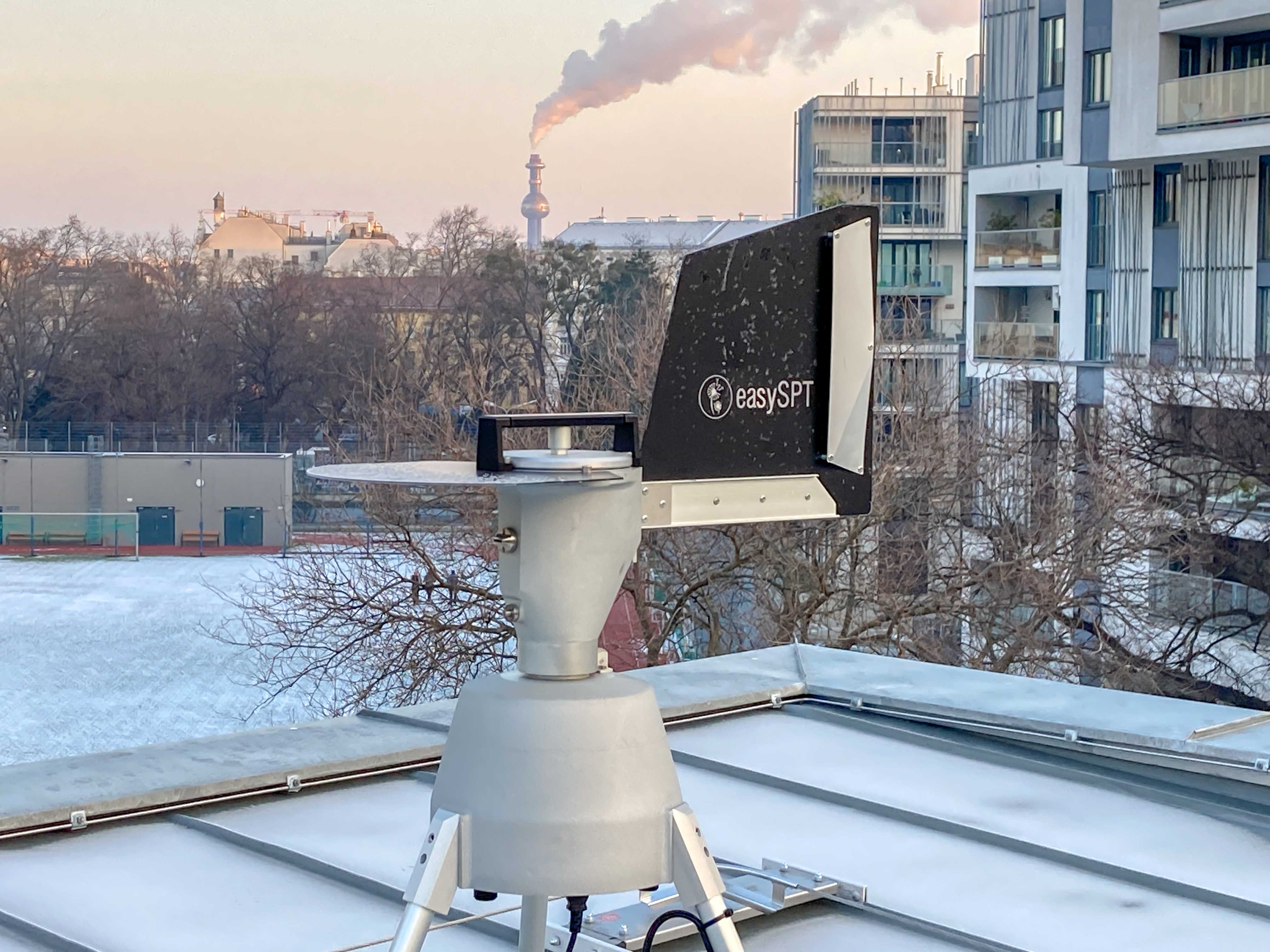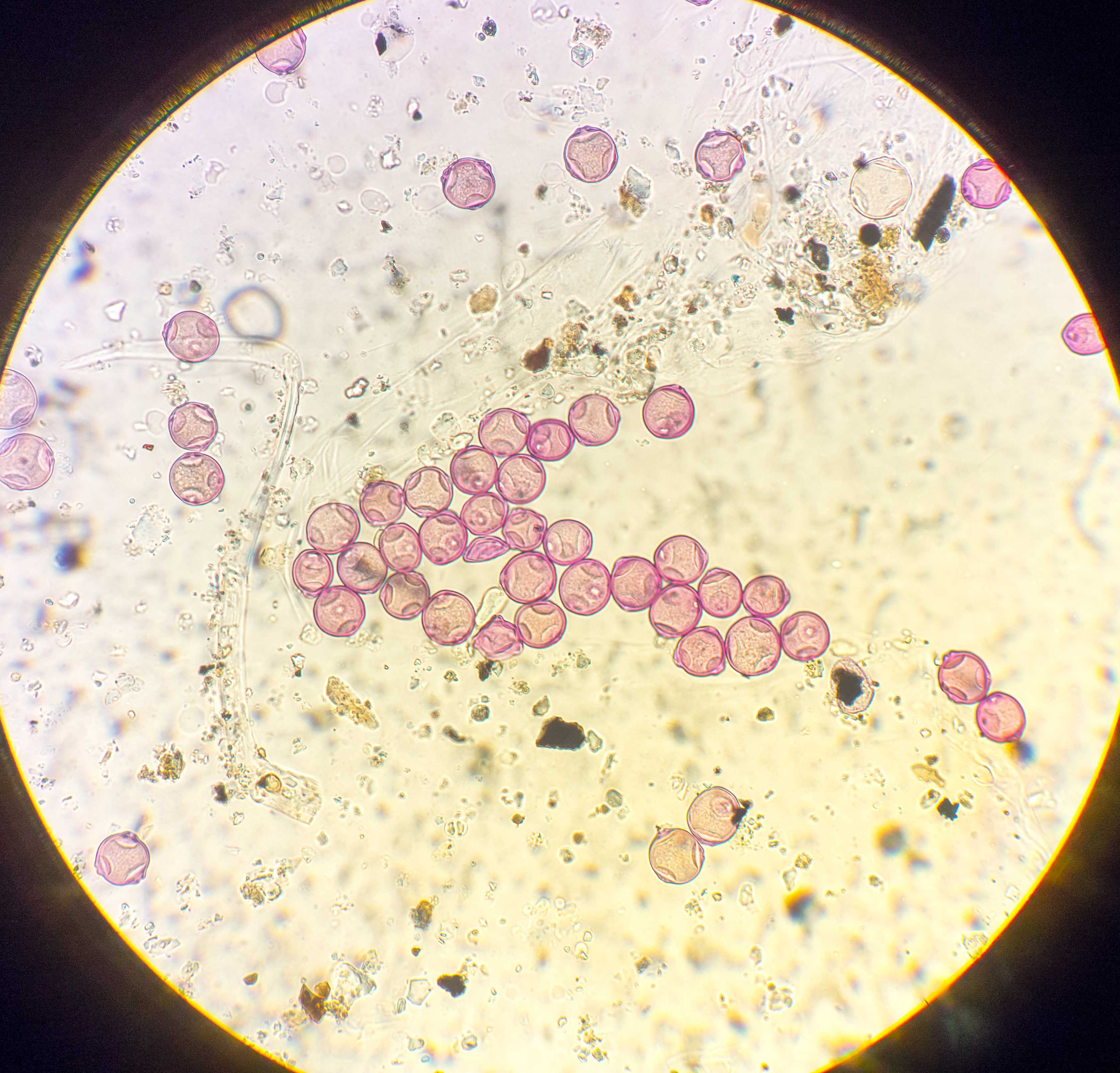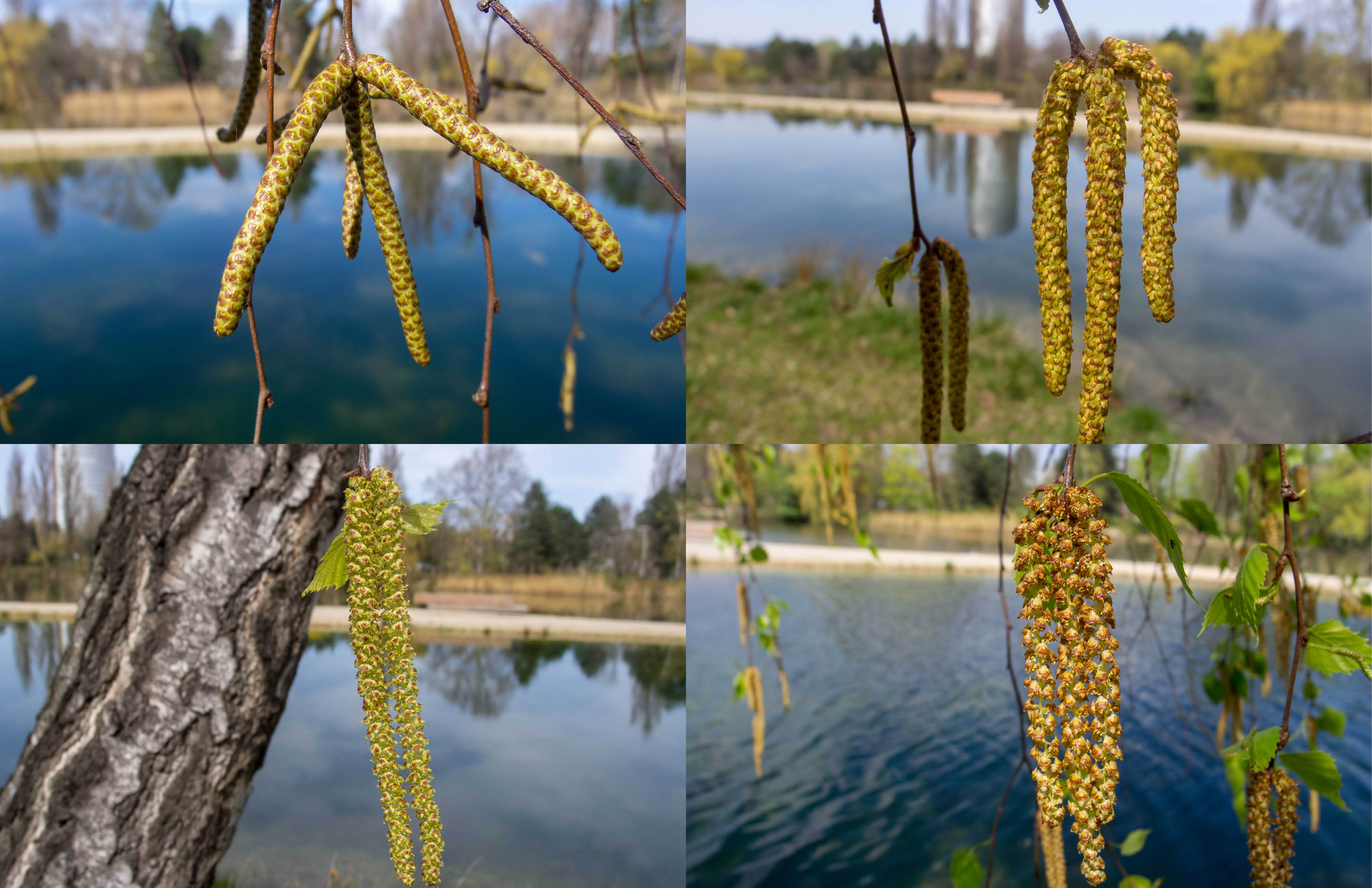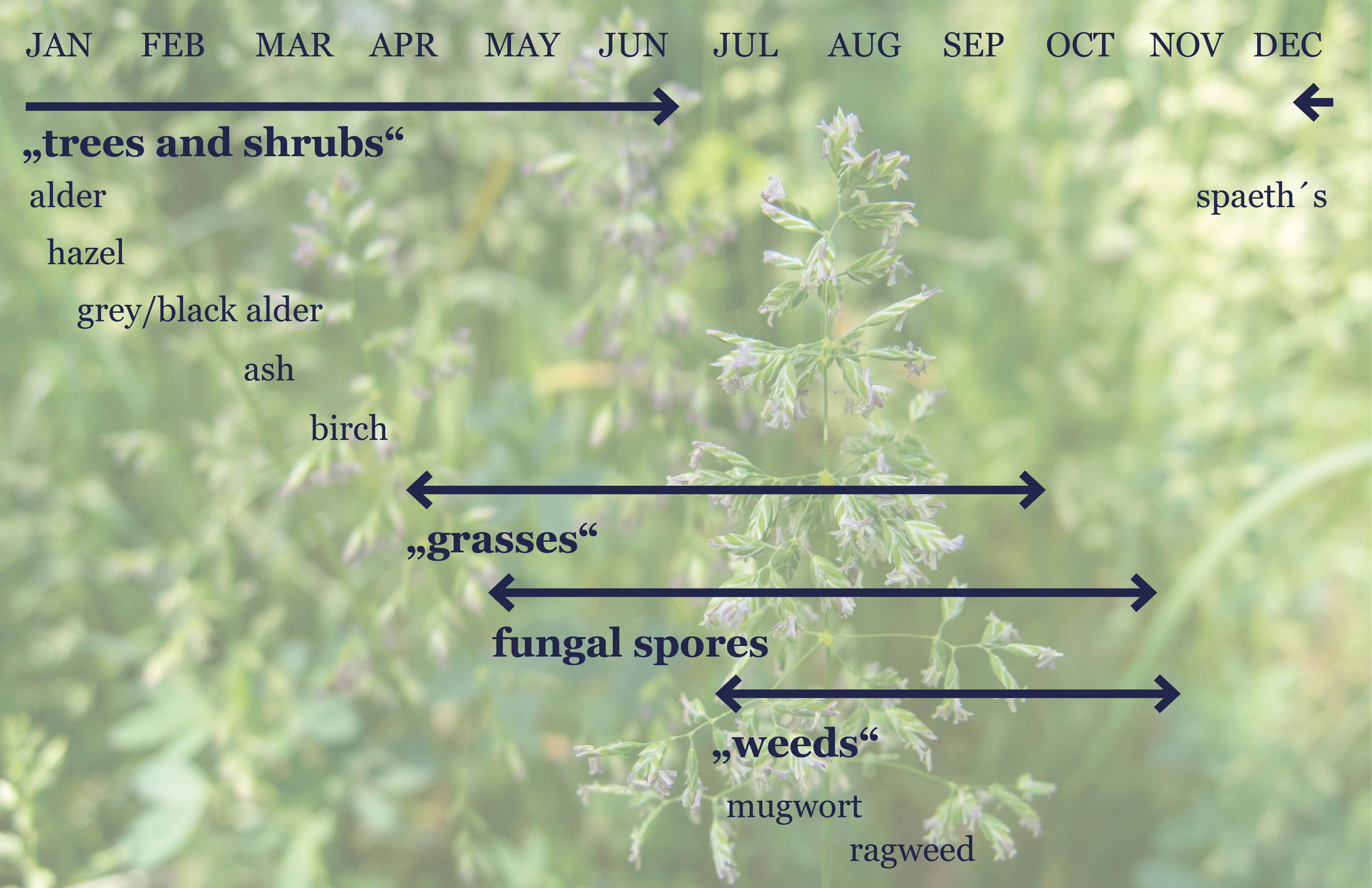Pollen forecast: Which pollen is in the air? Background for an improved understanding of the forecasting routine
Pollen forecasts or pollen prognoses are a complex matter. They are not read off an instrument or calculated by a computer – at least not yet. We want to provide here a guideline for an improved understanding of our tasks and an insight into who we are, what we do and why we do it (this way).
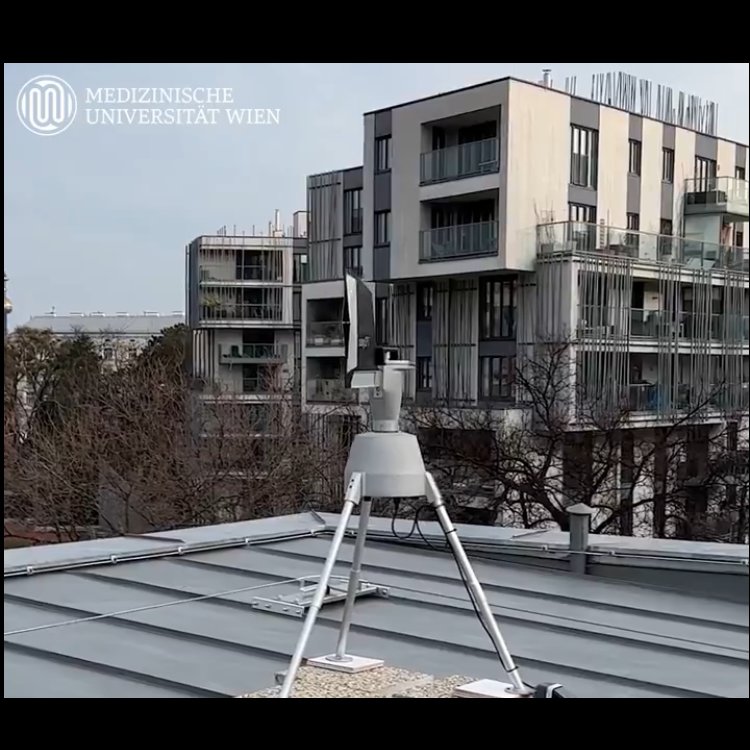
After activation, data will be sent to YouTube. Further information here: Data protection
Here you see a video, that gives you an insight in our (agrobiological) routine work at the MedUni Vienna (language: German).
How is a most accurate pollen forecast achieved?
The first ingredient would be pollen data if there would be a recipe for a pollen forecast. Nothing can be said about the development of the situation without the knowledge of past and current pollination. Pollen data is collected mostly with the classic pollen and spore traps of the Hirst design in Europe (Figure 1).
Air is sucked into the pollen trap and all particles within this air adhere to a sticky tape inside the trap, that is moved in a defined velocity. That way, information on the temporal component is known, in other words when those particles were in the air. The sticky tapes are prepared in the laboratory and then examined by pollen analysts under the light microscope. Every pollen grain (depending on the team also fungal spores) is identified based on its morphology (=appearance) and counted (Figure 2).
There is a European standard (ÖNORM EN-16868:2019) for the handling of the pollen trap, preparation and pollen evaluation, which nearly all European institutions follow. This scientific approach makes pollen data precious for many other scientific questions (Climate Change, Ecology, Allergology), but requires an appropriate education of personnel and time. Efforts are made since some time to automatize the evaluation of pollen (more on this topic below).
The other ingredients for an accurate forecast are: weather forecasts, phenology and expertise. There are of course other possible sources, that can be included after careful examination such as pollen forecast models. The four mentioned ones seem essential to us for a basic recipe.
The more accurate the weather forecast is, the better the pollen forecast will be. Weather has a significant impact on the readiness to flower, the start of the flower, the full flower (peak of pollination) and the end of the flower. Not only precipitation, but also temperature, sunshine duration and in some cases other parameters such as wind direction are relevant.
Phenology (classification of the flowering stage in outdoor nature) is often neglected. It is a traditional method in botany and seems to be unsexy nowadays and is relatively time consuming. However, it was not yet possible to replace phenology completely. The knowledge of the local flora, the observation of selected reference plants on a regular basis and the documentation of the flowering development provides insights into nature to assess and forecast pollination (Figure 3).
Some phenomena are even not observable without phenology. An example for Vienna would be the Spaeth´s alder, that does not cause measurable pollination. Therefore, we are on the way also during Christmas time. The flower of grasses is a similar case. Pollen grains of different grass species and even genera cannot be distinguished in the light microscope. Only the observation in the field can give answers which grasses are flowering.
Not to forget, expertise should be mentioned. Alas there is no education for the work in the field of pollen forecasts. Everyone, who feels enabled to, could theoretically distribute pollen forecasts. It stays difficult to judge the provided quality from outside. Most providers are located at universities in Europe, not only because such institutions are confidence-building, but also because it would be difficult to provide pollen forecasts for free and without advertisement or sponsorships. Unprejudiced assessment of the situation may not always be guaranteed, especially in terms of financial interests.
Small excursion to the latest state of technology in pollen evaluation
Approaches towards automatization and attempts to integrate artificial intelligence (AI) into the work of pollen evaluation have been made as a matter of course also in the field of aerobiology (“biology of the air”). It is worked on these attempts continuously and it would not be surprising, if things would change within the next years.
Models for pollen distribution run since quite some time successfully and may support in the preparation of pollen forecasts. This step was made, although the responsible team for a pollen forecast must judge the current quality of the model and how (much) to integrate these data into a forecast, no matter if a textual forecast or as display in values defined beforehand.
Currently, different „machines“ are available, that provide different results with different methods (image recognition, laser). Summarizing it can be said that there is no adequate replacement yet, that would cover all aspects of the evaluation from a human analyst, as for example:
- instant recognition of new pollen (e.g. neophytes)
- broad taxonomic coverage (evaluation of every pollen grain and not only selected pollen types)
- archiving of the data source (re-evaluation not possible via laser recognition)
- standardization
However, it is already worked on these points. The temporal component is the main obstacle for the application of AI. The automated evaluation currently needs far too much time. To what extent these new approaches should be already used in the routine work of a pollen service is subject to controversial discussion. We believe that these approaches are promising, but the application should be carefully considered and that to our current knowledge a human team should be in charge in the preparation of pollen forecasts and any information, that is communicated to the public. It is a great responsibility to inform people about pollination, since pollen allergies are a disease, that requires a behaviorally change on occasion. Therefore, a pollen forecast has an impact that should not be underestimated.
Which pollen is in the air now?
This is the question occupying most people, who note that their pollen allergies start. You will find the answer in our textual pollen forecast and in our overview of the current pollination for the next three days. In addition, we provide pollen calendars for a long-term planning.
We summarize here as a short overview of the most important sources of pollen allergy: Spaeth´s alder flowers at the end of the year/beginning of the year, followed by hazel and the native alder species in wintertime – also known as “early flowering trees”. The flower of ash must be expected from March onwards, followed by birch, which is frequently overlapping with the flower of grasses. We designed a pollen calendar for the season of grasses in Vienna, because pollination of grasses is composed of the flower of many different grass species. Not everyone is reacting on every grass. The flower of weeds is starting in summertime, first by mugwort, then by ragweed, which flowers until autumn.
What do we do differently and why?
We have developed a new concept, that poses an important change in the communication of pollination. We refrain from the old “load classes”. First of all, these are often misleading for the public in our experience and lead to more questions than answers (“What is the difference between moderate and high?”). Additionally, it is currently discussed how far thresholds – fixed pollen concentration levels – are meaningful since they vary from region to region and from allergen to allergen.
In a recent study from Switzerland, clinical data showed that the dose-response curve is very attenuated and that there does not appear to be a threshold above which symptoms begin (Luyten et al. 2024).
On the other hand, it is known for a long time that the reaction of every concerned person is individual and a generalization of the burden from pollen allergies is not expedient but leads to frustration of the concerned person (“I suffer since a long time.” Vs. „I do not experience any discomfort.“).
Therefore, we count on simplification: we provide three levels – no/hardly any pollination (green), pollination (yellow) and high pollination (red). Our new code is applied to the display of the current pollination for the next three days and should communicate the situation in a fast and clear way. This concept goes back to a scientific pioneer work from 2013, which already described that a simpler communication of pollination as a traffic light system would be desirable for pollen allergy sufferers (Kiotseridis et al. 2013). The recent study from Switzerland (Luyten et al. 2024) confims this approach.
Therefore, we decided to follow this simple road and are curious how this approach is accepted. In addition, we relate always to pollination and the observed flower and do not talk about the “burden”. The burden occurs based on many parameters and different influence factors are individually relevant, e.g.: stress (work/school), quality of sleep, hormonal status, diet and other (health) factors.
Who is the Pollenservice Vienna?
The Pollenservice Vienna was developed in autumn 2023 and went into operation by the end of 2023. There was no separate service for Vienna before (as for example there is for Tyrol, Salzburg, Carinthia, and Upper Austria), but only a voluntary association as Austrian “Pollenwarndienst”, which is not available anymore at www.pollenwarndienst.at. The MedUni Vienna made every effort to prevent a supply gap by the establishment of the Pollenservice Vienna.
We – the researcher and married couple Katharina and Maximilian Bastl – have developed and set up the Pollenservice Vienna. We have experience for more than a decade in this field and strive for this topic since both of us suffer from pollen allergies.
We hope to serve you optimally with relevant information concerning pollination, invite you to follow us on X, Bluesky, Instagram or TikTok for more insights in the everyday life of an aerobiologist (“Pollenpaar Bastl”) and hope to be able to support you on your way.
References:
Kiotseridis H., Cilio C.M., Bjermer L., Tunsäter A., Jacobsson H., Dahl A. 2013. Grass pollen allergy in children and adolescents – symptoms, health related quality of life and the value of pollen prognosis. Clinical and Translational Allergy 22(3):19. Doi: 10.1186/2045-7022-3-19
Luyten A., Bürgler A., Glick S., Kwiatkowski M., Gehrig R., Beigi M., Hartmann K., Eeftens M. 2024. Ambient pollen exposure and pollen allergy symptom sevirity in the EPOCHAL study. Allergy 79:1908-1920. Doi: 10.1111/all.16130
